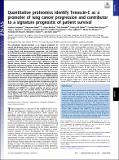Quantitative proteomics identify Tenascin-C as a promoter of lung cancer progression and contributor to a signature prognostic of patient survival
Author(s)
Gocheva, Vasilena; Naba, Alexandra; Bhutkar, Arjun; Guardia, Talia; Miller, Kathryn; Li, Carman Man Chung; Dayton, Talya L.; Sanchez-Rivera, Francisco Javier; Kim-Kiselak, Caroline; Jailkhani, Noor; Winslow, Monte Meier; Del Rosario, Amanda M.; Hynes, Richard O.; Jacks, Tyler E.; ... Show more Show less
DownloadE5625.full.pdf (4.003Mb)
PUBLISHER_POLICY
Publisher Policy
Article is made available in accordance with the publisher's policy and may be subject to US copyright law. Please refer to the publisher's site for terms of use.
Terms of use
Metadata
Show full item recordAbstract
The extracellular microenvironment is an integral component of normal and diseased tissues that is poorly understood owing to its complexity. To investigate the contribution of the microenvironment to lung fibrosis and adenocarcinoma progression, two pathologies characterized by excessive stromal expansion, we used mouse models to characterize the extracellular matrix (ECM) composition of normal lung, fibrotic lung, lung tumors, and metastases. Using quantitative proteomics, we identified and assayed the abundance of 113 ECM proteins, which revealed robust ECM protein signatures unique to fibrosis, primary tumors, or metastases. These analyses indicated significantly increased abundance of several S100 proteins, including Fibronectin and Tenascin-C (Tnc), in primary lung tumors and associated lymph node metastases compared with normal tissue. We further showed that Tnc expression is repressed by the transcription factor Nkx2-1, a well-established suppressor of metastatic progression. We found that increasing the levels of Tnc, via CRISPR-mediated transcriptional activation of the endogenous gene, enhanced the metastatic dissemination of lung adenocarcinoma cells. Interrogation of human cancer gene expression data revealed that high TNC expression correlates with worse prognosis for lung adenocarcinoma, and that a three-gene expression signature comprising TNC, S100A10, and S100A11 is a robust predictor of patient survival independent of age, sex, smoking history, and mutational load. Our findings suggest that the poorly understood ECM composition of the fibrotic and tumor microenvironment is an underexplored source of diagnostic markers and potential therapeutic targets for cancer patients.
Date issued
2017-06Department
Massachusetts Institute of Technology. Department of Biology; Koch Institute for Integrative Cancer Research at MITJournal
Proceedings of the National Academy of Sciences
Publisher
National Academy of Sciences (U.S.)
Citation
Gocheva, Vasilena et al. “Quantitative Proteomics Identify Tenascin-C as a Promoter of Lung Cancer Progression and Contributor to a Signature Prognostic of Patient Survival.” Proceedings of the National Academy of Sciences 114, 28 (June 2017): E5625–E5634 © 2017 The Authors
Version: Final published version
ISSN
0027-8424
1091-6490